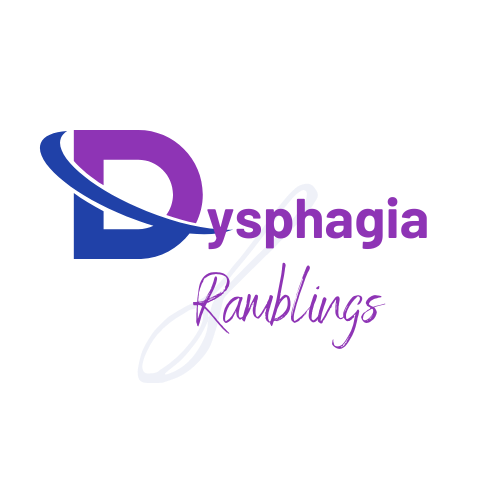
Have you ever taken a moment to look at and assess your own treatment and evaluation techniques? Have you been using the same techniques and exercises for 20 years?
Too often we become content with what we’re doing and stop looking to new research to continue to grow in our profession.
Dysphagia is a rapidly progressing field with new research published all the time.
How often are we completing the same clinical swallowing evaluation without modifying the technique? We often do the same oral motor assessment and watch the patient eat. We don’t always assess using measurable techniques such as peak flow, lingual measurements from Lazarus, or even a cranial nerve exam.
-
Lazarus, C.L., Husaini, H., Jacobson, A.S., Mojica, J.K., Buchbinder, D., Okay, D., & Urken, M.L. (2014). Development of a New Lingual Range-of-Motion Assessment Scale: Normative Data in Surgically Treated Oral Cancer Patients. Dysphagia, 29(4), 489-499.
Perhaps we are not providing enough education to other medical professionals to actually understand what we’re doing. Somewhere along the line we have educated physicians and nurses that we complete a modified barium swallow study to rule out or confirm aspiration or penetration. They often don’t realize the extent of our assessment and how we are assessing anatomy and physiology including techniques to change both to increase efficiency of the swallow.
- Stop “watching” patients in the dining room.
In her evaluation and treatment book Dr. Logemann wrote that therapy should be separate from the dining room. That we should not be sitting with the patient at the table watching them eat and then billing for therapy.
Dr. Carnaby gave us a list at the original Florida Dysphagia Institute including a dissection of what a treatment session should look like. The treatment session, according to Dr. Carnaby should include:
- No talking (chit chat)
- No compensation
- Aggressive Intervention
- Verbal, visual feedback
- Direct in repetitions, effort, control
A dysphagia therapy session should focus on rehabilitation of the swallow, when the patient is appropriate. We should be providing feedback and pushing the swallow to the limits and beyond. Our exercises and goals should utilize exercise principles and the principles of neuroplasticity.
2. Stop not recommending instrumental assessment.
There is no way to accurately determine bolus flow once the mouth has closed and to see anything pharyngeally without instrumentation. Once the mouth is closed we are only making an educated guess at best. Instrumental assessments are critical to our accurate diagnosis of dysphagia and treatment planning. Doctors can look at a patient and see that they’ve had a stroke, but will require a CT scan or MRI to determine the location and nature of the stroke, which is critical to treatment. Not every person will require instrumentation however with the increasing availability of Flexible Endoscopic Evaluation of Swallowing (FEES) and Modified Barium Swallow Studies (MBSS) we need to use utilize these assessments when appropriate.
3. Stop asking for an instrumental assessment to determine if the patient is aspirating.
Instrumentation has so many uses beyond identifying aspiration. A radiologist can determine if a patient is aspirating. As an SLP we should be using the MBSS to determine “why” the person is aspirating. We should be looking at anatomy and physiology, trialling compensatory strategies, determining accuracy of completion of maneuvers such as the Mendelsohn and maybe even watching NMES under fluoro. This should be an assessment to develop an appropriate therapy protocol. Using a protocol such as MBSImP can help to standardize the Modified Barium Swallow Study (MBSS).
We are skilled Speech Language Pathologists. We need to show this through our assessment and treatment, particularly with changes to healthcare and changes to payment systems. Let’s start using the skills we have acquired!
References
Logemann, J. A. (1998). Evaluation and treatment of swallowing disorders.
Martin-Harris, B., Brodsky, M. B., Michel, Y., Castell, D. O., Schleicher, M., Sandidge, J., … & Blair, J. (2008). MBS measurement tool for swallow impairment—MBSImp: establishing a standard. Dysphagia, 23(4), 392-405.

Thanks for this kick in the pants! It’s just what I needed to get myself moving back in the right direction. I appreciate the insight and reminder to inventory the level of skilled services I am providing.
I need that myself!!! It’s so easy to settle into a routine!
Good advice! However, please read through again as there are several typos and perhaps auto corrections that disrupt the integrity of the article. 🙂
I’m not sure what happened there. I think I fixed it.
Hi,
In the UK we are advised to have medical cover on site for FEES, as well as suction and oxygen.
This feels extreme as it’s such a safe procedure, but is a barrier to a nursing home (SNF) service.
We can arrange for a medic to be at the nursing home, and can get portable suction, but oxygen is a real barrier. It would be even more difficult in a patient’s home!
I don’t think the evidence supports this view, but interested to know if you’ve come up against these barriers in your practice!
Thanks!
Here is the US FEES procedures are interpreted by state. The wording varies state by state but usually it’s “under physician supervision” which is interpreted differently everywhere.
Hello!
Is it possible to have the references cited in this article?
I’m interested particularly on Lazarus peak lingual flow and Dr. Carnaby indications.
Thak you so much!
Hi! I’m sorry for the delay. I’m not sure where I have found the time to sleep lately! I will add the references before the end of the week. I thought they were there, but I must have forgotten to add them! Thank you!
Also, the Carnaby reference is from a talk that she gave, so there is no article to find regarding that. Just the information provided.